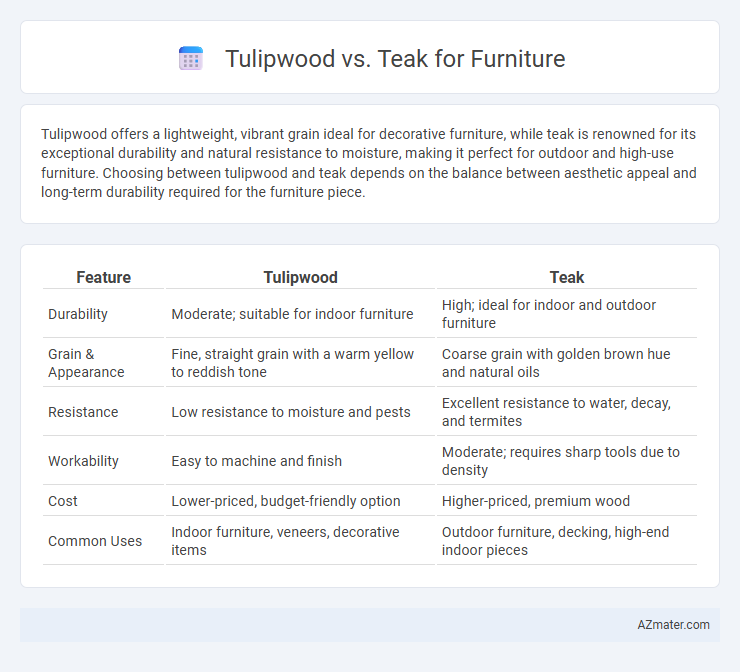Tulipwood offers a lightweight, vibrant grain ideal for decorative furniture, while teak is renowned for its exceptional durability and natural resistance to moisture, making it perfect for outdoor and high-use furniture. Choosing between tulipwood and teak depends on the balance between aesthetic appeal and long-term durability required for the furniture piece.
Table of Comparison
| Feature | Tulipwood | Teak |
|---|---|---|
| Durability | Moderate; suitable for indoor furniture | High; ideal for indoor and outdoor furniture |
| Grain & Appearance | Fine, straight grain with a warm yellow to reddish tone | Coarse grain with golden brown hue and natural oils |
| Resistance | Low resistance to moisture and pests | Excellent resistance to water, decay, and termites |
| Workability | Easy to machine and finish | Moderate; requires sharp tools due to density |
| Cost | Lower-priced, budget-friendly option | Higher-priced, premium wood |
| Common Uses | Indoor furniture, veneers, decorative items | Outdoor furniture, decking, high-end indoor pieces |
Introduction: Why Compare Tulipwood and Teak for Furniture?
Tulipwood and teak are popular hardwoods valued for furniture due to their durability, aesthetic appeal, and workability. Comparing tulipwood and teak helps highlight differences in grain patterns, weather resistance, and cost-effectiveness essential for making informed decisions in interior and outdoor furniture design. Understanding their unique characteristics benefits craftsmen and consumers seeking long-lasting and visually appealing wood choices.
Origin and Availability of Tulipwood and Teak
Tulipwood primarily originates from North America, especially the eastern United States and Canada, where it is harvested from the tulip tree (Liriodendron tulipifera). Teak, on the other hand, is native to Southeast Asia, particularly Myanmar, Thailand, and India, and is prized for its durability and natural oil content. Tulipwood is generally more abundant and affordable compared to teak, which is often sourced from managed plantations or endangered natural forests, making teak less available and more expensive in the global market.
Color and Grain: Visual Differences
Tulipwood features a warm, reddish-brown hue with a smooth, fine grain that often displays subtle, wavy patterns, creating an elegant and contemporary look in furniture. Teak boasts a rich golden-brown to dark brown color with a straight, coarse grain texture and occasional oily sheen, adding a classic, robust appearance. The visual contrast lies in Tulipwood's lighter, more uniform coloring versus Teak's deeper, more varied tones and distinctive grain patterns.
Durability and Hardness Compared
Tulipwood and teak are both popular hardwoods used in furniture, but teak is significantly more durable and harder, making it ideal for outdoor and high-traffic use. Teak's natural oils provide exceptional resistance to moisture, rot, and insects, resulting in furniture that can last for decades with minimal maintenance. Tulipwood, while moderately hard and suitable for indoor furniture, lacks the dense grain and oil content that give teak its superior longevity and toughness.
Weather Resistance: Indoor vs. Outdoor Suitability
Tulipwood offers moderate weather resistance, making it more suitable for indoor furniture, as prolonged exposure to moisture and sunlight can cause warping and discoloration. Teak is highly weather-resistant due to its natural oils and dense grain, allowing it to withstand outdoor elements like rain, humidity, and UV rays without deteriorating. For outdoor furniture, teak provides superior durability and low maintenance compared to tulipwood's vulnerability in harsh weather conditions.
Workability and Ease of Crafting
Tulipwood offers excellent workability due to its fine, even grain and moderate hardness, making it easier to cut, shape, and sand compared to teak. Teak, while highly durable and resistant to moisture, presents challenges in crafting because of its oily texture and dense fibers, which can blunt tools and require specialized equipment for smooth finishes. For furniture makers prioritizing ease of crafting and detailed work, tulipwood is generally more user-friendly, whereas teak demands experience and precise tool maintenance.
Maintenance and Longevity
Tulipwood requires regular sealing and occasional refinishing to maintain its smooth surface and resist moisture damage, making its maintenance moderately intensive in comparison to teak. Teak is highly durable with natural oils that provide excellent resistance to rot, insects, and weather, necessitating minimal maintenance and prolonging its lifespan significantly. Over time, teak furniture often outlasts tulipwood due to its superior longevity and ability to maintain structural integrity under various environmental conditions.
Environmental Impact and Sustainability
Tulipwood is a fast-growing hardwood sourced primarily from North America, making it a more sustainable option due to shorter harvesting cycles and lower environmental impact compared to teak. Teak, native to tropical Asia, grows slowly and is often harvested from old-growth forests, raising concerns about deforestation and loss of biodiversity. Choosing plantation-grown teak certified by organizations like FSC can mitigate environmental damage, but tulipwood generally offers a greener alternative for eco-conscious furniture buyers.
Cost Comparison: Tulipwood vs. Teak
Tulipwood is significantly more affordable than teak, with prices typically ranging from $3 to $7 per board foot compared to teak's $15 to $30 per board foot. This substantial cost difference makes tulipwood a budget-friendly choice for furniture while still offering good durability and aesthetic appeal. However, teak's higher price reflects its superior resistance to moisture, insects, and decay, making it a premium option for long-lasting, high-end furniture.
Which is Best for Your Furniture Needs?
Tulipwood offers a lightweight, pale finish with moderate durability, making it ideal for indoor furniture where aesthetic appeal and ease of handling matter. Teak, renowned for its exceptional hardness, natural oils, and resistance to moisture and pests, is the preferred choice for outdoor furniture and high-traffic areas requiring long-lasting strength. Choosing between tulipwood and teak depends on your specific furniture needs, balancing factors such as durability, maintenance, and environmental exposure.

Infographic: Tulipwood vs Teak for Furniture
 azmater.com
azmater.com